Click on images to enlarge

infestation along a waterway (Photo: Sheldon Navie)

habit (Photo: Sheldon Navie)
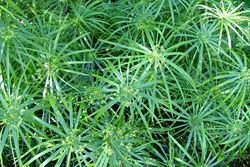
habit (Photo: Sheldon Navie)

reddish-brown leaf sheaths at the base of the stems (Photo: Sheldon Navie)
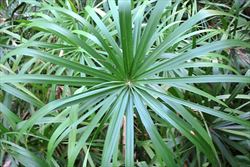
cluster of large leafy bracts at top of stem, prior to development of the seed-head (Photo: Sheldon Navie)
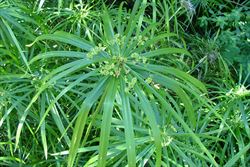
leafy bracts subtending a young seed-head (Photo: Sheldon Navie)
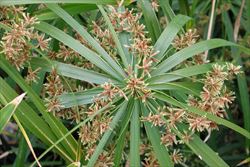
much-branched mature seed-head (Photo: Sheldon Navie)

close-up of mature seed-head showing clusters of spikelets at tips of branches (Photo: Sheldon Navie)

close-up of elongated flower spikelets (Photo: Sheldon Navie)
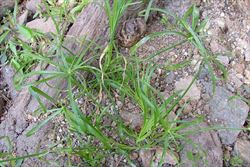
young plants (Photo: Sheldon Navie)
Scientific Name
Cyperus involucratus Rottb.
Synonyms
Cyperus alternifolius L. subsp. flabelliformis Kük.Cyperus flabelliformis Rottb.
Family
Cyperaceae
Common Names
African sedge, dwarf papyrus grass, false papyrus, flat sedge, umbrella flatsedge, umbrella palm, umbrella plant, umbrella sedge, windmill sedge
Origin
Native to eastern Africa (i.e. Eritrea, Ethiopia, Somalia, Sudan, Kenya, Tanzania, Uganda, Malawi, Mozambique, Zimbabwe and South Africa), Madagascar and the Arabian Peninsula (i.e. Yemen).
Cultivation
Often cultivated as a garden ornamental, particularly in ponds and water features.
Naturalised Distribution
Widely naturalised in eastern Australia (i.e. in south-eastern, central and northern Queensland and in the coastal districts of central and northern New South Wales) and also scattered in the southern and northern parts of the country (i.e. in the coastal districts of Western Australia and in some parts of South Australia and the Northern Territory. Also naturalised on Lord Howe Island and Norfolk Island.
Widely naturalised elsewhere in tropical and sub-tropical regions of the world (e.g. southern USA, Hawaii, numerous Pacific islands and New Zealand).
Habitat
It is a weed of damp sites (e.g. creeks, wetlands, swamps, drainage channels and ditches) in tropical, sub-tropical and warmer temperate regions.
Habit
A long-lived (i.e. perennial) reed-like plant with upright (i.e. erect) stems usually growing 45-120 cm tall, but occasionally reaching up to 1.5 m in height.
Distinguishing Features
- a reed-like plant with basal leaves reduced to sheaths.
- it produces several upright stems (up to 120 cm tall) topped with large seed-heads.
- these branched seed-heads are subtended by many green leafy bracts that have an umbrella-like appearance.
-
the seed-heads have about eight main branches (5-10 cm long) radiating from the top of the stem.
-
at the tips of these branches are clusters of elongated flower spikelets that turn reddish-brown as they mature.
Stems and Leaves
The upright (i.e. erect) stems (3-5 mm thick) are rigid and triangular to almost cylindrical in cross-section (i.e. trigonous to sub-terete). They are hairless and sometimes slightly ridged lengthwise.
The true leaves are reduced to long sheaths that cover the bases of the stems. However, the very large leafy bracts that are clustered below the seed-heads (i.e. inflorescences) are often confused for leaves.
Flowers and Fruit
The seed-head (i.e. inflorescence) has about eight branches (5-10 cm long) which radiate outwards from the top of the stem. These branches are further divided into several some smaller branches (i.e. secondary branches) 1-2 cm long. At the base of the seed-head (i.e. inflorescence) is a cluster (i.e. whorl) of 12-22 large green leafy bracts. These bracts (up to 30 cm long and 2 cm wide) can easily be mistaken for leaves and are much longer than the branches of the seed-head. At the tips of the seed-head branches are the numerous elongated (i.e. oblong-lanceolate) and flattened flower spikelets that are arranged in dense clusters. These flower spikelets (3-9 mm long and 1.7-3 mm wide) are initially light green in colour, but they turn reddish-brown as they mature. Each flower spikelet consists of 6-30 tiny florets. The florets each have a bract (i.e. glume) about 2 mm long, a style topped with three elongated stigmas, and three stamens.
The 'seeds' (i.e. nuts or achenes) are yellowish or brown in colour, somewhat oval (i.e. ellipsoid) in shape, and three-sided or triangular in cross-section (i.e. trigonous). These seeds are about 1 mm long and have a projection at the tip (i.e. beaked apex) that is also about 1 mm long.
Reproduction and Dispersal
These species reproduces mainly by seed, though it can spread to form large clumps via short underground stems (i.e. rhizomes).
Seeds and stem segments (i.e. pieces of rhizome) are commonly dispersed to new areas by water and in dumped garden waste.
Environmental Impact
This species is regarded as an environmental weed in Queensland, Western Australia and the Northern Territory. It has escaped cultivation and become established along waterways and in wetlands, particularly near habitation. It is of particular concern in south-eastern Queensland, where it is very common along waterways and regarded to be among the top 100 most invasive plants. It has also been reported from conservation areas in South Australia (e.g. Cleland Conservation Park and Sturt Gorge Recreation Park).
Umbrella sedge (Cyperus involucratus) also invades marshy areas and stream edges in Hawaii, and in New Zealand it is a persistent weed of roadside gutter channels.
Legislation
Not declared or considered noxious by any state government authorities.
Similar Species
Umbrella sedge (Cyperus involucratus) is very similar to dwarf umbrella sedge (Cyperus albostriatus) and relatively similar to drain flat-sedge (Cyperus eragrostis), which is sometimes also called umbrella sedge. These species can be distinguished by the following differences:
- umbrella sedge (Cyperus involucratus) is a relatively large plant (45-150 cm tall) with a cluster of numerous (12-22) large leafy bracts (up to 30 cm long and 2 cm wide) below its seed-heads. The leaves at the bases of its stems are reduced to sheaths.
- dwarf umbrella sedge (Cyperus albostriatus) is a relatively small plant (20-60 cm tall) with a cluster of several (7-11) broad leafy bracts (5-15 cm long and 5-25 mm wide) below its seed-heads. It has several well-developed leaves at the base of it stems.
- drain flat-sedge (Cyperus eragrostis) is a relatively small plant (usually 25-60 cm tall) with a cluster of several (5-9) narrow leafy bracts (usually 3-30 cm long and 1.5-8 mm wide) below its seed-heads. It has several well-developed leaves at the base of it stems.

